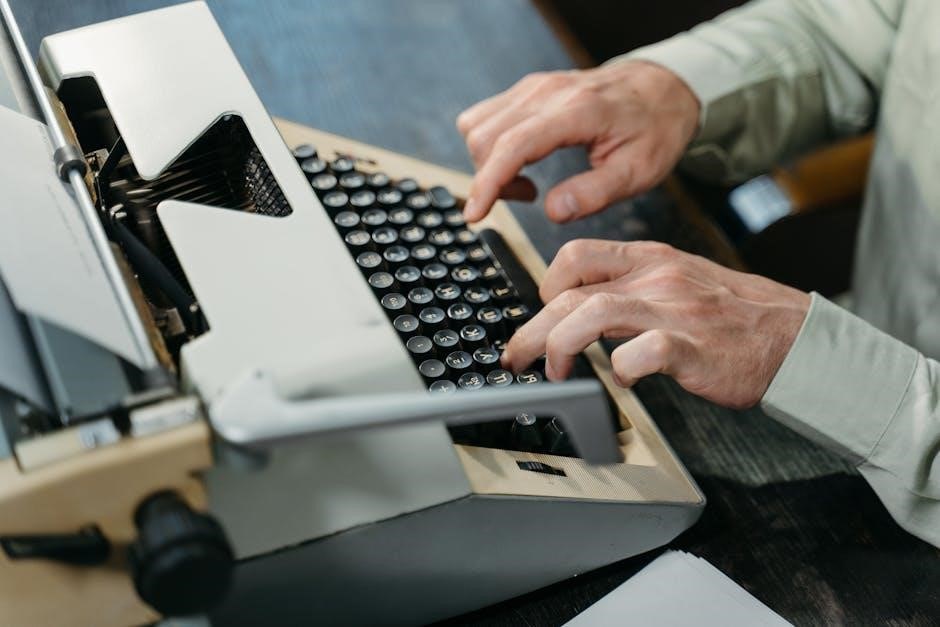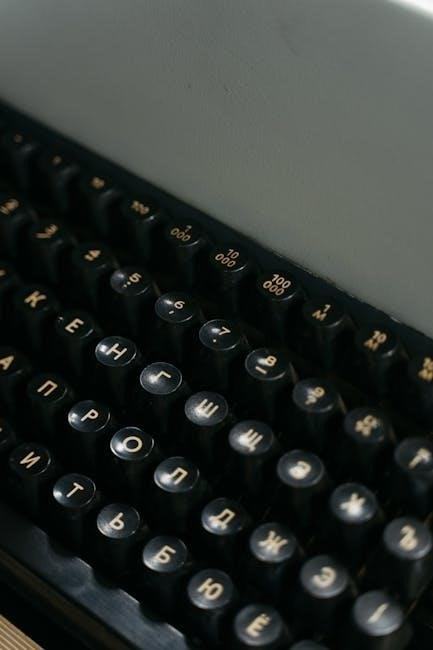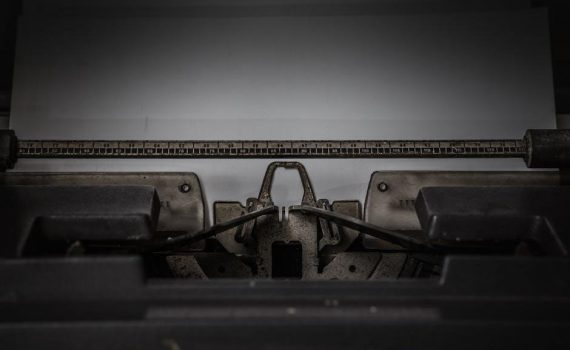heat press instruction manual
Category : Instructions
This manual provides comprehensive guidance for operating and maintaining your heat press, ensuring safe and effective use for various projects, including fabrics, mugs, and metal boards.
1.1. Purpose of the Manual
This manual is designed to guide users in safely and effectively operating their heat press. It covers setup, operation, and maintenance, ensuring optimal performance for various materials like fabrics, mugs, and metal boards. The guide provides detailed instructions for temperature control, pressure adjustment, and troubleshooting, making it a comprehensive resource for both beginners and experienced users. By following this manual, users can achieve professional-quality results while minimizing risks and extending the machine’s lifespan.
1.2. Target Audience
This manual is intended for individuals, businesses, and professionals using heat presses for various applications. It caters to crafters, small business owners, and skilled operators working with materials like fabrics, mugs, and tiles. Whether you’re a beginner or an experienced user, this guide provides essential information to ensure safe and efficient operation. The instructions are tailored to meet the needs of both hobbyists and commercial users, helping them achieve optimal results in their projects.
1.3. Safety Precautions
Safety is paramount when using a heat press. Always wear protective gloves and eyewear to prevent burns and injuries. Ensure the machine is placed on a heat-resistant surface and kept away from flammable materials. Avoid touching the heat platen during operation, as it reaches extremely high temperatures. Unplug the device when not in use or during maintenance. Follow the manufacturer’s guidelines for temperature settings to prevent overheating. Proper ventilation is recommended to avoid inhaling fumes from materials being pressed. Regularly inspect the machine for damage to ensure safe operation.

Unpacking and Assembly
Inspect the heat press for damage upon unpacking. Carefully remove all components and place them on a stable, heat-resistant surface. Follow the manual’s assembly guide to ensure proper setup and functionality.
2.1. Unpacking the Heat Press
When unpacking your heat press, carefully inspect the machine for any visible damage or defects. Ensure all components, such as the heat platen, pressure adjustment knob, and power cord, are included. Place the heat press on a stable, heat-resistant surface to avoid accidental damage. Remove any packaging materials and protective coverings from the heat platen and other parts. Allow the machine to cool down if it has been in transit, as the heat platen may retain residual heat. Check for additional accessories like Allen wrenches or instruction booklets, which may be packed separately for safe transportation.
2.2. Assembly Instructions
Begin by assembling the heat press according to the manufacturer’s guidelines. Attach the heat platen securely to the machine using the provided screws and tools, ensuring proper alignment. Next, adjust the pressure knob to achieve even distribution. Position the machine on a sturdy, flat surface and ensure it is level. Connect the power cord to a suitable electrical outlet and perform a test run to ensure all components function correctly. Refer to the included diagrams for precise assembly steps, and tighten all bolts firmly to prevent movement during operation.
2.3. Machine Dimensions and Heat Platen Size
The heat press dimensions vary by model, typically ranging from 15×15 inches to 24×36 inches for industrial units. The heat platen size determines the maximum material size that can be pressed. Ensure the machine fits your workspace and meets your project requirements. Measure the platen size accurately to align designs properly. Refer to the manufacturer’s specifications for exact measurements, as sizes differ between models. Properly matching the platen size to your needs ensures efficient and precise heat transfer for optimal results.

Understanding the Heat Press Components
The heat press comprises essential elements such as the heating plate, digital temperature controls, pressure adjustment knobs, and a timer, each designed for precise control and safe operation.
3.1. Heat Platen
The heat platen is a vital part of the heat press, designed to distribute heat evenly for consistent results. Proper preheating ensures the desired temperature for various materials. Regular cleaning prevents residue buildup and maintains efficiency. Use a heat-resistant surface to protect the platen from damage. Avoid overcrowding and ensure items are evenly spread for optimal performance. Always wear protective gloves when handling the platen, as it becomes extremely hot. Never place materials directly on the platen without a heat-resistant layer to prevent scorching or damage.
3.2. Temperature Control Panel
The temperature control panel is essential for regulating heat press operations. It features a digital display for precise temperature monitoring and adjustment buttons to set desired heat levels. This panel ensures consistent heating, crucial for various materials. Use the +/- buttons to adjust temperatures, and rely on the panel’s accuracy for optimal results. Regular calibration is recommended to maintain precision. Always refer to the manual for specific temperature guidelines to avoid overheating or underheating. Proper use of this panel ensures safe and efficient heat transfer for all projects.
3.3. Pressure Adjustment
Pressure adjustment is crucial for achieving optimal results with your heat press. The pressure knob allows you to customize the force applied to your materials. Light pressure is ideal for delicate fabrics, while heavier pressure suits thicker materials like metal or wood. Always refer to material guidelines for specific pressure recommendations. Ensure even pressure distribution to prevent uneven transfers. Avoid excessive pressure, as it may damage the heat platen or your projects. Adjust gradually, testing on scrap material if needed, to find the perfect balance for your work.
3.4. Timer and LED Display
The timer and LED display are essential for precise control during heat pressing. The timer allows you to set the exact duration for pressing, ensuring optimal transfer without overexposure. The LED display shows the countdown, current temperature, and other settings, providing real-time monitoring. Once the timer reaches zero, the press will signal completion, allowing safe opening. Always ensure the timer is accurately set, as incorrect timing can affect results. Use the LED display to verify settings before starting the cycle for consistent, professional-quality outcomes.

Setting Up the Heat Press
Set up your heat press by plugging it in, placing it on a stable surface, and performing initial calibration for optimal performance.
4.1. Initial Calibration
Initial calibration ensures accurate temperature and pressure readings. Plug in the machine, let it warm up, and use the control panel to set the desired temperature. Adjust the pressure knob to the recommended level for your material. Refer to the manufacturer’s guidelines for specific calibration steps. Once set, test the heat press with a scrap material to confirm proper function. Calibration ensures even heat distribution and consistent results. Recalibrate periodically, especially after extended storage or transport, to maintain accuracy and performance.
4.2. Parameter Setting Guide
The parameter setting guide helps you configure the heat press for optimal results. Start by selecting the material type and desired outcome. Adjust the temperature, pressure, and time based on the material’s thickness and sensitivity. For fabrics, lower temperatures and shorter times are recommended, while thicker materials like metal boards may require higher settings. Refer to the chart in the manual for specific guidelines. Fine-tune settings during initial tests to achieve the best results. Proper parameter setup ensures consistent and professional-quality finishes for your projects.
4.3. Temperature and Time Settings
Set the temperature between 200°F to 400°F, depending on the material. Cotton fabrics typically require 300°F to 350°F, while polyester needs 250°F to 300°F. Adjust the timer from 10 to 300 seconds based on material thickness and sensitivity. Start with shorter times for delicate items and increase as needed. Preheat the press for 10-15 minutes before use. Monitor settings to avoid overheating or underheating, ensuring proper adhesion and durability of designs. Always refer to the material manufacturer’s guidelines for precise settings.

Operating the Heat Press
Operating the heat press involves turning it on, setting temperature and time, loading the press, and ensuring safe, consistent pressure application for optimal results.
5.1. Heating Up the Machine
To begin, plug in the heat press and turn it on. Set the desired temperature using the control panel, typically between 200°F to 400°F depending on the material. Allow the machine to preheat for 10-15 minutes until the LED display shows the set temperature. Ensure the heat platen is clean and dry before use. Always monitor the temperature to avoid overheating, and never touch the heat platen with bare hands. For specific materials, consult the manual for recommended settings to ensure optimal results and safety.
- Preheating time: 10-15 minutes.
- Avoid touching the heat platen;
- Keep children away during operation.
5.2. Transferring Designs
Once the machine is preheated, carefully place your material on the heat press bed, ensuring the design is centered. Position the transfer paper with the printed side facing down onto the material. Close the heat press evenly and apply gentle pressure. Allow the machine to transfer the design for the recommended time, usually 10-20 seconds. For best results, follow the manufacturer’s settings for pressure and temperature specific to your material. Let the press cool slightly before opening to avoid shifting the design.
5.3. Cooling Down the Machine
After completing your project, turn off the heat press and unplug it to ensure safety. Allow the machine to cool down naturally at room temperature. Never use water to cool it, as this can damage the internal components. The cooling process typically takes about 30 minutes, depending on usage. Once cooled, clean the heat platen with a dry cloth to remove any residue. Regular cooling helps maintain the machine’s performance and longevity, ensuring optimal results in future projects.
Temperature Settings
Temperature settings are critical for achieving optimal results. The heat platen temperature typically ranges from 200°F to 400°F, depending on the material and design complexity. Always refer to the material manufacturer’s guidelines for precise settings. Incorrect temperatures can damage materials or result in poor adhesion. Adjust settings carefully to ensure consistent and professional-quality outcomes. If unsure, consult the manual or contact customer support for guidance.
6.1. Recommended Temperatures for Different Materials
For cotton fabrics, set the temperature between 300°F and 350°F. Polyester materials require slightly lower settings, typically between 250°F and 300°F. Blends should be pressed at 280°F to 320°F. For special materials like metal or glass, higher temperatures (350°F to 400°F) are often necessary. Always refer to the material manufacturer’s guidelines for specific recommendations. These are general starting points, and precise settings may vary based on the product and design complexity. Testing on scrap material is advised to ensure optimal results.
6.2. Adjusting Temperature for Specific Projects
Adjusting temperature for specific projects ensures optimal results. For delicate fabrics like silk or rayon, reduce the heat by 20-30°F to prevent damage. When working with thick materials or multi-layered designs, increase the temperature by 10-20°F. Substrate thickness and design type also influence settings. Always pre-test a small area to avoid over-heating. Fine-tune adjustments in 5°F increments, monitoring the outcome. This customization ensures vibrant, long-lasting transfers and prevents substrate damage, enhancing project durability and quality. Proper adjustment is key to achieving professional-grade finishes.

Pressure and Time Settings
Proper pressure and time settings are crucial for achieving desired results. Adjust pressure based on material thickness and type, ensuring even force distribution. Time settings vary depending on substrate and design complexity, with typical ranges between 10 to 300 seconds. Always refer to the material’s recommended guidelines for optimal pressing. Balanced settings ensure vibrant, durable transfers without damaging the substrate.
7.1. Pressure Adjustment Guide
Adjusting the pressure on your heat press ensures even contact between the heat platen and substrate. Start by setting the pressure knob to the middle position and test-press scrap material. For delicate fabrics, reduce pressure to prevent damage. Thicker materials or those with embellishments may require higher pressure. Use the pressure gauge to monitor settings, ensuring even distribution. Avoid over-tightening, as this can warp the platen or damage the machine. Always refer to the manufacturer’s guidelines for specific material recommendations.
7.2. Time Settings for Optimal Results
Accurate time settings are crucial for achieving the best results with your heat press. The ideal time depends on the material type, thickness, and design complexity. Common ranges are 10-30 seconds for vinyl and 2-5 minutes for thicker materials like metal or tiles. Always preheat the press and test on scrap material. Use the timer precisely to avoid under-heating or over-heating, which can damage the substrate or design. Proper time settings ensure durable, vibrant transfers and extend the lifespan of your heat press.

Compatible Materials and Applications
Explore compatible materials and applications for your heat press, including fabrics, ceramics, metal boards, and more, ideal for customizing t-shirts, mugs, tiles, and various creative projects.
8.1. Fabrics
Fabrics are a primary material for heat pressing, ideal for creating custom designs on apparel and textiles. Cotton, polyester, and blended fabrics work best, as they withstand high temperatures. Avoid silk, nylon, or delicate fabrics that may burn or melt. Pre-wash fabrics to remove finishes that might interfere with transfers. Use a heat-resistant sheet to protect fabrics during pressing. For optimal results, ensure fabrics are dry and ironed before applying designs. Popular applications include t-shirts, tote bags, and baby clothes, making fabric the most versatile material for heat press projects.
8.2. Non-Fabric Materials
Non-fabric materials like ceramic, glass, and wood can also be used with a heat press for unique projects. Mugs, tumblers, and metal boards are popular choices for transferring designs. Ensure materials are heat-stable and compatible with sublimation or heat transfer vinyl. Always check manufacturer guidelines for specific materials. Use a protective sheet to prevent damage from heat and pressure. Proper temperature and pressure settings are crucial to avoid warping or cracking. Experiment with different materials to expand your creative possibilities beyond fabrics.
8.3. Printable Items and Max Size
Heat presses can be used to print on various items, including t-shirts, mugs, phone cases, and more. The maximum size of printable items depends on the heat platen dimensions. Measure your material to ensure it fits within the platen size for even heating. Always check the manual for specific size recommendations. Oversized items may not press evenly, leading to poor results. Use a ruler or template to align designs accurately. Experiment with different sizes to maximize your creative output while adhering to machine limits.

Common Projects Using Heat Press
A heat press is ideal for creating custom t-shirts, mugs, phone cases, and more. It’s perfect for fabric, vinyl, and sublimation projects, offering versatility and ease of use.
9.1. T-Shirts
A heat press is perfect for creating custom t-shirts with vibrant designs. Use heat transfer vinyl or sublimation prints for durable results. Preheat the press to 300-350°F, depending on the fabric. Place the design on the shirt, ensuring proper alignment. Apply firm pressure for 10-15 seconds. For best results, use a temperature-resistant sheet to protect the garment. Ideal for cotton, polyester, or blends, this method ensures long-lasting, professional-quality designs. Perfect for personalized gifts, promotional items, or artistic expressions.
9.2. Mugs and Tumblers
Customizing mugs and tumblers is straightforward with a heat press. Use sublimation prints or heat transfer vinyl for vibrant, long-lasting designs. Preheat the press to 300-400°F, depending on the material. Place the design on the mug, ensuring proper alignment. Apply moderate to high pressure for 3-5 minutes. Use a mug press attachment for even heat distribution. Ideal for ceramic, glass, or metal tumblers. Allow the mug to cool slightly before handling. Perfect for personalized gifts, promotional items, or unique drinkware designs.
9.3. Metal Boards and Tiles
Heat presses can be used to customize metal boards and tiles for decorative or functional purposes. Ensure the metal surface is clean and free of contaminants for optimal adhesion. Use heat transfer vinyl or sublimation prints, suitable for metal substrates. Set the temperature between 300-350°F and apply medium to high pressure for 5-7 minutes. Allow the metal to cool before handling. Protective gloves and eyewear are recommended during the process. This method is ideal for creating durable, long-lasting designs on metal surfaces, perfect for signage, wall art, or personalized gifts.

Maintenance and Troubleshooting
Regularly clean the heat platen, check power cords for damage, and ensure proper alignment. For common issues like uneven pressure or temperature fluctuations, adjust settings or contact support.
10;1. Cleaning the Heat Press
Regular cleaning is essential to maintain the heat press’s performance. Turn off and unplug the machine, then allow it to cool completely. Use a soft, damp cloth to wipe the heat platen and surfaces, avoiding harsh chemicals. For stubborn residue, mix a small amount of mild detergent with distilled water and gently scrub. Never use abrasive cleaners or metal scrapers, as they can damage the non-stick coating. Dry thoroughly with a clean cloth to prevent rust or water spots. This routine ensures optimal heat distribution and longevity.
10.2. Replacing Parts
Replacing parts on your heat press is essential for maintaining its functionality. Always use genuine or compatible replacement parts to ensure safety and performance. Start by unplugging the machine and allowing it to cool. Refer to the manual or manufacturer’s website for specific part numbers. Use basic tools like screwdrivers to remove and install components. For complex parts, consider consulting a professional. Regularly inspect elements like the heat platen, pressure springs, and gaskets for wear. Replacing these promptly prevents damage and ensures consistent results. Store spare parts in a dry, clean environment to maintain their quality.
10.3. Common Issues and Solutions
Common issues with heat presses include uneven pressure, incorrect temperature readings, or the timer malfunctioning. For uneven pressure, adjust the pressure springs or recalibrate the machine. If temperature readings are off, check the thermocouple or heating element for damage. For timer issues, reset the machine or replace the timer module. Always unplug the press before troubleshooting. Refer to the manual for specific error codes and solutions. Regular maintenance can prevent many of these issues, ensuring smooth and consistent operation. Addressing problems promptly extends the machine’s lifespan and performance quality.

Advanced Techniques
Explore advanced techniques to enhance your heat press projects. Master multi-color transfers, specialty materials, and complex layering for professional results. Precision and creativity combined.
11.1. Double-Sided Printing
Double-sided printing allows you to create vibrant designs on both sides of a substrate. For best results, align the design carefully using a jig or centering tool. Ensure the first side cools completely before flipping to print the second side to prevent heat interference;
Adjust the pressing time slightly for the second print to avoid over-application. This technique works well for fabric, ensuring both sides are evenly printed without compromising quality or adhesion. For materials with low adhesion, use a parchment sheet to prevent lifting during the second print cycle.
11.2. Using Heat Transfer Vinyl
Heat transfer vinyl (HTV) is a popular material for creating custom designs. Cut your design in mirror mode using a vinyl cutter, then weed excess vinyl. Place the design on the substrate, ensuring proper alignment. Set the heat press to 280-300°F (138-149°C) with medium pressure. Press for 10-15 seconds, then allow it to cool slightly before peeling. For best results, use a parchment sheet to prevent vinyl sticking to the platen. Always follow the vinyl manufacturer’s temperature and time guidelines for optimal adhesion and durability.
Layering HTV is possible but requires careful timing. Apply the base layer first, let it cool, then add subsequent layers. Avoid overlapping vinyl too much, as it can cause peeling. Use a lower temperature for delicate fabrics like polyester blends. For intricate designs, pre-press the substrate to remove moisture and ensure even heat distribution. Proper application ensures vibrant, long-lasting designs on fabrics, mugs, and other compatible materials.
11.3. Layering Designs
Layering designs allows for complex and multi-colored graphics. Start with the base layer, pressing at a lower temperature to prevent damage. Apply subsequent layers one by one, ensuring each is cool before adding the next. Use parchment paper to protect the design. For intricate details, adjust pressure slightly. Layering works best with heat transfer vinyl or sublimation. Refer to the temperature guide for specific materials. Proper timing and cooling ensure vibrant, professional results without peeling or cracking. This technique is ideal for creating detailed, multi-color designs on fabrics and other compatible materials.
When layering, always test a small sample first. Adjust heat press settings as needed for material thickness. Avoid over-layering, as it may cause uneven adhesion. For delicate fabrics, reduce pressure and temperature. Layering is perfect for achieving intricate designs, logos, or multi-tone patterns. Ensure alignment is precise to maintain design integrity. Clean the platen between layers to prevent residue buildup. Proper layering enhances durability and visual appeal, making it a versatile technique for both beginners and advanced users.
Downloading the Manual
Visit the manufacturer’s official website, navigate to the support section, and enter your heat press model number to download the PDF manual instantly.
12.1. Finding the Correct Manual for Your Model
To find the correct manual, visit the manufacturer’s website and search for your specific heat press model number. Ensure the model number matches your machine exactly, as instructions vary by series and features. If unsure, refer to the product packaging or purchase documentation for the correct model details. Some manufacturers also provide a lookup tool on their support page for easy access. Always verify the manual version corresponds to your machine for accurate guidance.
12.2. PDF Versions and Manufacturer Links
Most heat press manuals are available as downloadable PDFs on the manufacturer’s official website. Visit the support or resources section and enter your model number to access the PDF. Ensure you download from trusted sources to avoid unauthorized versions. Some manufacturers also provide direct links via email upon purchase. Save the PDF to your device for easy reference and future use. Always cross-check the manual’s version with your machine’s specifications for accuracy and compatibility.
13.1. Final Tips for Effective Use
To maximize your heat press experience, always maintain a clean workspace and use the right accessories. Regularly inspect and replace worn-out parts. Experiment with different settings on scrap material before final projects. Keep a record of successful settings for future reference. Store the machine in a dry, cool place when not in use. Lastly, explore advanced techniques like layering or double-sided printing to expand your creative possibilities. Happy pressing!
13.2. Warranty and Customer Support
Your heat press is backed by a limited warranty covering manufacturing defects for a specified period. Register your product online to activate the warranty and receive exclusive updates. For inquiries or issues, contact customer support via phone, email, or live chat. Refer to the manual for troubleshooting before reaching out. Visit the official website for detailed warranty terms, repair options, and contact information. Ensure all repairs are performed by authorized technicians to maintain warranty validity and machine performance.
